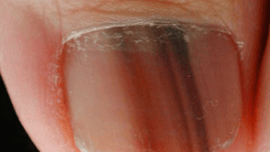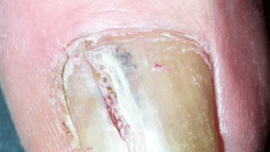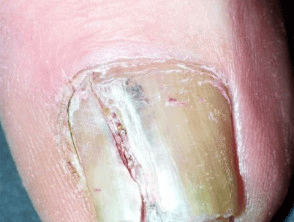Subungual Melanoma
Patient Information
Overview
Subungual melanoma is a type of melanoma of the nails that arises from the nail matrix, tissues of the nail bed. Sometimes, melanoma may be mistaken for other conditions of the nail, such as fungal infection or a bruise. While subungual melanoma is relatively a rear condition, early detection and treatment is necessary to avoid serious complications.
Symptoms
Unlike melanoma of the skin, subungual melanoma is typically identified with a mole on the skin. However, it may have other distinctive symptoms, including:
- A pigmented band of light to dark-brown, blue, or black colored streaks running vertically from the top of the nail through the cuticle, known as Hutchinson’s sign
- The band becomes wider, especially at its proximal end (cuticle)
- Dark nail pigmentation that expands to the surrounding skin
- A nodule underneath the nail with or without a pigmented band
- The site of pigmentation may ulcerate or bleed
- Nail thinning, cracking or distortion of the nail plate (nail dystrophy).
However, up to half of subungual melanoma cases do not have these symptoms. Also, it is usually painless, unless the tumor develops to invade the bone and cause severe pain. While this can make melanoma more difficult to detect, the condition usually affects one nail at a time.
Images of Melanoma of the nail unit



Causes
Subungual melanoma affects 0.7% to 3.5% of people with malignant melanomas worldwide. Although the cause of subungual melanoma is unclear, the risk factors include:
- Previous trauma to the fingers or toes
- Personal or family history of melanoma
- Between the age of 40-70
- Darker skinned individuals, including African American, Asian, and Hispanic populations
- Multiple moles
- Immune suppression, such as organ recipients and people with advanced HIV
Unlike other skin cancer, studies have found no association of sun exposure (ultraviolet radiation) with subungual melanoma.
Doctor Examination
While it is difficult to detect subungual melanoma on your own, you should contact your doctor right away if you notice any unusual changes or growths in your nail.
During your doctor examination, he/she will carefully inspect your nail and lesion with a dermascope. This is a magnifying instrument used by dermatologists to examine the nail and surrounding tissue. However, visual examination alone can sometimes arrive at a misdiagnose for conditions with similar symptoms, such as:
- Subungual haematoma (bruising beneath the nail)
- onychomycosis (fungal infections)
- Nevi (moles)
- Deposits of melanin beneath the nail due to pregnancy, chemotherapy, or radiation therapy
For a definitive diagnose, your doctor will conduct a biopsy. In most cases, he/she will conduct a punch biopsy using a tube-like instrument to make a puncture through the nail to collect tissues from the nail matrix and nail bed. The tissues will be sent to the lab to confirm your diagnosis and rule out other conditions.
Stages of Subungual Melanoma
Subungual melanoma can metastasize to other parts of the body if left untreated. To determine the stage of cancer, your doctor will take into account the size and depth of the tumor, as well as ordering various other tests. Your oncologist may conduct a biopsy of sentinel lymph nodes (nodes closest to the tumor), computerized tomography (CT scan), or positron emission tomography (PET scan). Similar to other types of cancer, stages of subungual melanoma start at a pre-cancer stage, medically known as “carcinoma in situ,” all the way to stage four metastatic disease as cancer spreads to other organs.
Treatment
Subungual melanoma must be treated surgically. Your surgeon will remove the entire nail then extract the tumor. Although this method is debatable, sometimes the end of the finger or toe is amputated.
Subungual Melanoma Outlook
Early diagnosis of subungual melanoma is essential to a successful treatment. However, delay in diagnosis is common with tumor in the toe and this can be detrimental depending on the thickness and metastasis of the tumors. Studies show that the 5-year survival rate ranges widely from 16% to 87%, with two larger series in the 51% to 55% range.
References:
Brannon, H. (2019). Subungual melanoma causes, diagnosis, and treatment. Retrieved from https://www.verywellhealth.com/subungual-melanoma-1069379
Cherney, K. (2017). Subungual melanoma. Retrieved from https://www.healthline.com/health/subungual-melanoma
Oakley, A. (2011). Melanoma of nail unit. Retrieved from https://dermnetnz.org/topics/melanoma-of-nail-unit/


